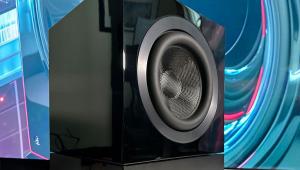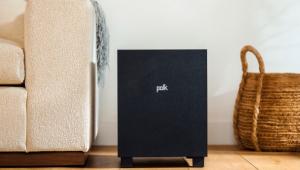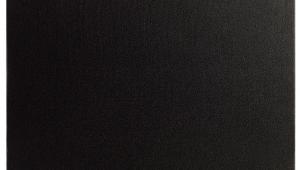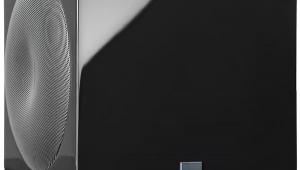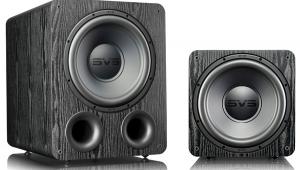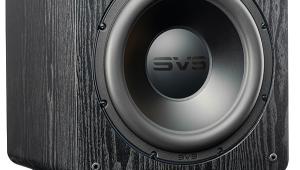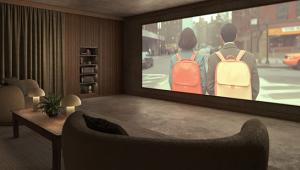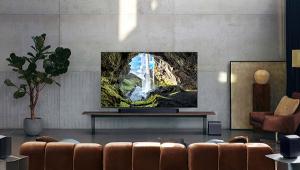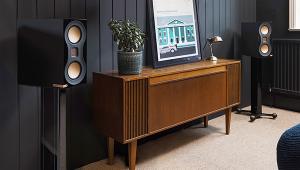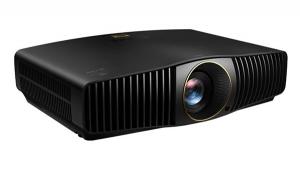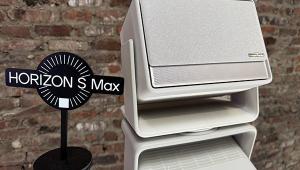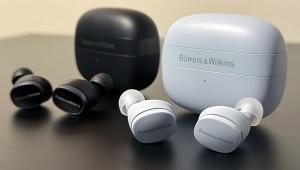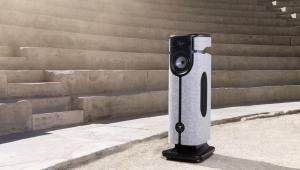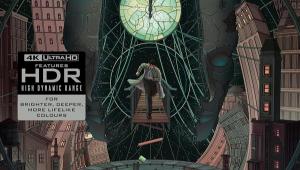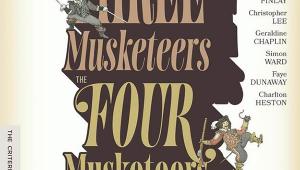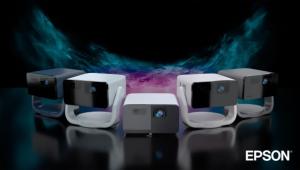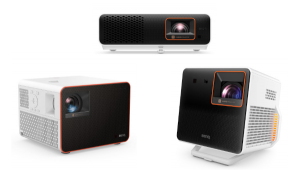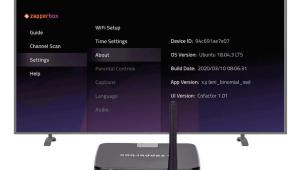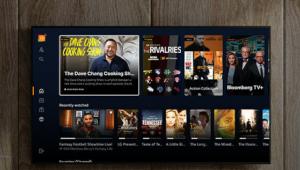Vera-Fi Audio Vanguard Scout Speakers, Vanguard Caldera 12 Subwoofer

AT A GLANCE
Plus
Scout & Caldera 12: Stylish and distinctive appearance, doesn’t look like a budget product
Scout & Caldera 12: Small enclosure
Scout & Caldera 12: Inexpensive
Caldera 12: XLR input
Minus
Scout: Low efficiency rating
Scout: A bit soft in the upper frequencies
Caldera 12: Small size imparts some limits on output and extension
Caldera 12: Bass Boost feature is centered at 120Hz
Caldera 12: Auto-on functions in an unorthodox manner
THE VERDICT
The midrange from the Vanguard Scout loudspeakers is silky smooth, while the Vanguard Caldera 12 subwoofer can go lower and play louder than its small size would suggest. At a very competitive price of $698 for a 2.1 system, Vera-Fi Audio gives you good sound quality that they bundle in unique and nicely finished cabinets. You can’t ask for more than that.
Ever hear of Vera-Fi Audio before? Neither had I, until this review. And that’s coming from the guy perhaps most associated to budget subwoofer evaluations, a person also known for finding under-the-radar brands. It’s not often a company like Vera-Fi would escape my gaze, but they did.
About 13 years ago I broke into the reviewing game by focusing on budget subs, those that cost $300 or less. I often wondered why so many people were asking questions on forums about inexpensive subwoofers, yet very few were actually being reviewed. I did some research and found out the reason why, in so doing it highlighted a gap in the system. I decided to fill it, and as I did my niche was born. For the next few years the bulk of the content I published was on budget-friendly options, but ultimately the pool started to dry up so I segued to more expensive and mainstream products. I still recall that time fondly however.
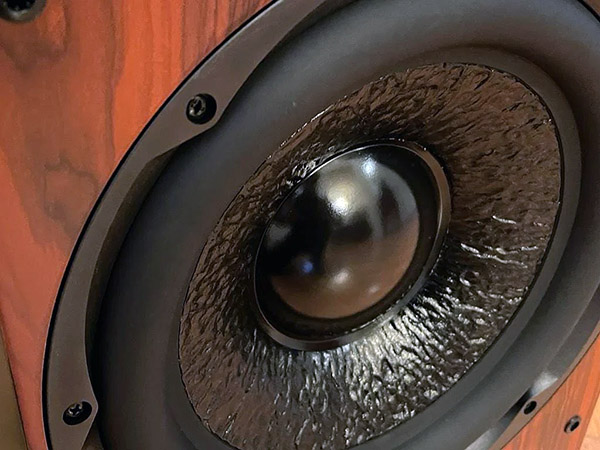
Today I get to go back to my roots with something inexpensive from a company less well known, should be right up my alley.
When you peruse Vera-Fi’s website you’ll find an eclectic mix of products, not just the Scout loudspeakers and Caldera 12 subwoofer I have right now. Among their offerings are amplifiers, Bluetooth modules, speaker stands, AC line conditioners and vibration isolators. There's even a cat-like statuette that “treats both acoustic and electric grounding.” They definitely have some unique things available.
Impressions
For this review I have a pair of the Scouts and a single Caldera 12, making this a 2.1 system. Retail price is just under $700.
Small is the first thing most people will think when they see the Vera-Fi Caldera 12. I’ve evaluated sealed subwoofers with a 12" driver that were larger than this thing, and yet it’s ported. Distinctive is likely the second thought that would come to mind. The top and side panels have a rosewood veneer finish; where they intersect there’s a chamfered edge painted satin black. The bottom of the cabinet appears almost plinth-like, it was coated in the same black paint. Vera-Fi went so far as to round the corners on the grill, who does that even on an expensive subwoofer? Somebody clearly spent a lot of time and effort to create a singular look. The price of the Caldera 12 says budget, its appearance does not.

Compact was my first impression of the Scout speakers as well. Their height and width are about as small as you could physically make them with this driver complement. They have some depth, but even that’s not a lot. I have them sitting on my own stands, which have a 5"×5" plate, and there are no stability issues. They wear the same very pleasing rosewood veneer as the Caldera. Sitting in my room, which has stained natural wood window frames and floor molding, the Scouts and Caldera looked right at home. The near-matching finish meant they fit in seamlessly.
Setup
Setting up the Caldera 12 and Scouts is all pretty straightforward; there aren’t a multitude of settings, no fancy connectors, no app, no elaborate configurations to concern yourself with. Except for a few adjustments on the sub, it’s mostly plug and play. You have the ubiquitous line-level (RCA) inputs, and rather unexpectedly—for a budget subwoofer—XLR as well. There’s a variable level control, a power mode switch with auto and always on, and another switch for normal or reverse phase. There’s also a bass boost feature, but it might have limited benefit. The enhancement it provides is centered around 120Hz, since most people use a crossover in the 80Hz range it may not be noticeable. Speaking of the crossover, the dial could use a few more markings to highlight the different settings. There are indications for 50Hz, 150Hz and LFE, but nothing else. That makes it a bit imprecise when choosing a crossover point. That’s really only a concern if you aren’t using the upstream electronics to set the crossover though.
The Scouts have an 84.5dB efficiency rating, which means they will require a bit of amplifier power. Don’t be surprised if you have to turn up the volume more than you might with some other speakers. It’s not necessarily a bad thing, just something to be aware of. One item that did catch me off guard was my standard-size banana plugs were too small to fit snugly into the binding posts, they flopped around. Since the posts are a 3-way design I simply used the opening intended for bare wire and loosely screwed them down. I wish all of life’s problems could be fixed so easily.
Listening/In Use
For those of you who have read any of my previous reviews that included speakers, you know I’m quite clear on what my number-one priority is: voices. In my opinion, if a speaker cannot do the human voice justice then it probably isn’t very accurate with much else. The reason being that voices are the thing we’re most familiar with, we hear them all day, every day. Young, old, male, female, deep, high pitched, accent—it doesn’t matter. Evolution has made us acutely aware of what our species sounds like, for me it’s one of the best indicators to use during an evaluation. With the Scouts selling for only $299/pair, something has to give, but me being me means I will still pay extra attention to that part of every song and movie soundtrack.
Because of my proclivities, the following line jumped out at me while I was reading about the Scouts on Vera-Fi Audio’s website:
"What makes the Scout special is the crossover and how it is voiced to provide a smooth presentation with pinpoint imaging and a wide soundstage."
While I’m not sure I would say the soundstage is notably wide, the comment about imaging and how smooth these speakers are proved to be quite accurate. The velvety nature of the Scouts is impressive given how inexpensive they are, these speakers are very easy to listen to for hours on end. But the true hero may be the imaging, time and time again I found myself admiring how the Scouts put sounds in the right space. The depth of their presentation was clearly evident, even during spirited listening sessions they maintained their composure. My notes are scattered with words like “balanced,” “coherent,” and “fluid.”
While the midrange produced by the Scouts was accomplished, I felt the top end was a little soft. Given it’s a silk dome tweeter the expectation would naturally be of an overall mellow sound, so I certainly wasn’t expecting it to be harsh or strident. Nevertheless, I would have preferred a touch more vibrancy. Removing the grill did liven things up somewhat, so I left them off for the duration of this review.
With the Caldera it was something I saw, rather than something I read, that caught my attention. One of the pictures on Vera-Fi Audio’s website shows the amplifier, and it prominently features a toroidal transformer.

There’s simply no way a $400 subwoofer should be able to incorporate something like that, yet there it is. The amp is housed in its own chamber, physically isolated from the driver. That minimizes the potential for the backwave from the driver to cause long-term issues with the amp due to vibrations. It’s certainly an unusual find in this price class. There is a single horizontal cabinet brace, along with damping material on the top and both side walls. The front baffle measures about 1.5" thick, the rest of the cabinet appears to be 3/4" of an inch. There’s not much in this paragraph that you can say about most other budget subwoofers; generally speaking they aren’t able to incorporate features like these.
During my time with the Caldera I found the amp somewhat sensitive to certain appliances. Despite the subwoofer being plugged into a different electric circuit, whenever my microwave was on, or the refrigerator’s compressor kicked in, the sub produced a hum. It had a similar sound to a ground loop, but I don’t have that issue in my house. I did hear a slight hum in general everyday use, it was just more pronounced when certain appliances were active.
Movies
Should I keep with tradition and use the intro to Edge of Tomorrow in this review? That’s a rhetorical question, of course I will. Budget system or not, I’m going to search for the limits. This is mostly punishment directed at the Caldera 12 however; the Scouts won’t have a lot to do here.
The sequence in question is five levels of pulsing bass notes, decreasing in frequency as they go. I’m not expecting much—this is a $400 subwoofer after all—but I will still crank the volume anyway. Despite going into it not having high hopes, I ended up walking away feeling the opposite. The Caldera 12 hit all five plateaus with a commendable amount of output, save for the last one. By that time the port was making some noise, as was the driver’s suspension, yet it soldiered on mostly unfazed. I ran through this scene a few times and by then the Caldera 12 had earned my admiration; a subwoofer in this price class really shouldn’t have been able to do what this one did.
Open Range is a Kevin Costner film I usually reserve for subwoofer evaluations; with the way gunshots are embellished in this film it’s a good option if you want to test sharp, deep notes. But it also has the critical speaker-testing element I mentioned earlier: voices. In this movie you have male, female, upper octave, lower octave, foreign, domestic. You name it, this movie has it. The scenes that stitch all those pieces together are 14 and 15, the ubiquitous showdown between good and evil.
Invariably, when those two forces meet there is an ominous musical score thrown in to build tension. The Scouts and Caldera willingly complied, creating the obligatory sense of impending doom. Just before the final showdown the protagonists meet face to face; this part is mostly dialog which the Scouts handled with ease. All the voices had a proper weight to them, each clear and recognizable.
In short order the on-screen action erupts into a gun battle, with the Caldera now having to pull its weight. It added the requisite depth to the various firearms used, each possessing a distinct impact signature that separated it from the others. The Scouts did their part as well, chipping in with ample amounts of detail. Ancillary elements—like gunshots echoing across the valley, horses whinnying, the sound of shattering glass—none of that was overshadowed by the action. Everything was layered in nicely. It’s worth reminding everyone at this point that I don’t have a center channel; it’s just two speakers carrying the full load.
Collateral is another movie I’ve used for evaluations, mostly when reviewing subwoofers like the previous two choices. There are portions that provide good speaker-test material though, like the battle in Club Fever, so that’s what I queued up. As the scene unfolds there is EDM music blaring, a throng of people dancing to the hypnotic beat. The Caldera 12 had the ability to deftly produce the bass notes, but wasn’t quite able to replicate the punch this type of music necessitates. I imagine few, if any, $400 subwoofers could. The Scouts seemed to enjoy themselves; the music was smooth, background noises—such as the clinking of glasses, or conversations off to the side—didn’t get overwhelmed by the driving beat of the music. The only area I wish was a touch more pronounced would be the high end; the somewhat muted presentation took a bit of the sparkle away.
When the guns came out, the intensity ratcheted up. Frequently, sound engineers will de-emphasize the subtle parts during these situations, instead focusing on the immediate action. I’m not so sure that’s a good idea as the perimeter sounds tend to make or break a scene like this. Things like brass hitting the ground after someone fires their gun, or screams from terrified people desperately trying to flee, make up the tapestry of those moments. The Scouts seemed to relish this part, producing those characteristics without breaking a sweat.
Heartbreak Ridge stars Clint Eastwood as grizzled old Marine Gunnery Sergeant Thomas Highway, a man who is about to retire from the Corps. Or get booted from it, depending upon your perspective. He gets himself assigned to his old unit to train one final reconnaissance platoon. There’s not much to challenge a subwoofer for pretty much the entire movie so I don’t drag it out often, but I do when there are speakers involved. Such is the case now, but to be honest I just felt like watching it. There are times while doing an evaluation that I don’t concentrate on only a few choice scenes, but rather just kick back and watch an entire movie simply because I enjoy it. Besides, the first couple of flicks had a lot of material for a subwoofer. It was time to skew the balance toward the Scouts.
Toward the beginning of the movie Eastwood is sitting in a bar, arguing with his ex-wife. There’s a band playing in the background, it was lively and energetic despite not being the focal point of the scene. A short while later, Sergeant Highway has his men taking target practice at the artillery range. The Caldera effortlessly handled the percussive blasts from the M16s as the Marines squeezed off round after round. Other aspects—like the mechanical sound of targets being raised and lowered, or bullet impacts—were blended in wonderfully by the Scouts.
Music
You can mask certain acoustic shortcomings when watching TV or movies, in part because you’re distracted by the visual stimulus, but when listening to music the same can’t be said. You’re more focused on the audio because that’s all there is; any deficiencies will be more prominent under those conditions. With that being said, I bring to your attention another quote from Vera-Fi Audio’s website…
"The balance and voicing of the Vanguard Scout is optimized for non fatiguing listening pleasure with all genres of music."
You bet I noticed that. While I’m not an “all genres of music” type of guy—I prefer rock and blues for the most part—I do have a few things in my collection that can test Vera-Fi’s voicing claim. Let’s start with those.

From Alanis Morissette’s Jagged Little Pill album I went with…well, you oughta know what I went with. Sorry, I couldn’t help myself. Bad pun aside, “You Oughta Know” is a great track to test Vera-Fi’s assertion that the Scouts are not fatiguing. The song opens with Alanis’s sultry voice doing a combination of speaking and singing; within short order she’s belting out lyrics. The transition from mild to wild was effortless, I could even hear Morissette’s slight breathlessness. Naturally the mix emphasizes her vocals, but the bass and drums get their due also. The Caldera 12 balanced out the presentation by not hiding in the background.
From Alanis to Amy, I jumped from one woman renowned for her powerful voice right to another: Amy Lee. I’ve never seen Evanescence live, but from what others have told me who did, her voice really is that powerful. Amy is purported to have co-founded Evanescence at the tender age of 13. I don’t know about you, but I was still popping zits in my early teens.
“Bring Me to Life” starts with a haunting piano intro and Lee’s incredible voice, both of which the Scouts ate up. There’s a synthesized bass drop underlying that, which the Caldera did its best to reproduce. The guitar had the guttural feel it was intended to; the cymbals felt a touch recessed though, and not quite cogent enough. The low end was sharp and precise.
From songs focused on vocals to an instrumental? You didn’t really expect me to do conventional, did you? Rewinding to something recorded two dozen years ago I reached for my old Blu-ray of Joe Satriani’s performance in San Francisco. I went right to “One Big Rush,” a song not unlike many of Joe’s, as it features a slick rhythm with plenty of guitar work. Stu Hamm’s bass was rollicking, complemented by Jeff Campitelli’s forceful drumming. The guitar had a boisterous feel, with Joe’s signature sound clearly evident. If you’ve ever seen Satch live, you know that’s exactly how it should be.
Conclusion
The term “budget” is affixed to audio equipment that doesn’t cost a lot of money. That label comes with a certain stigma which, too often, is warranted. Generally speaking, products in this category are designed to a price point more than anything else. That approach will result in some inevitable compromises. Then there’s Vera-Fi Audio, who seemingly took a different path when engineering their Scout speaker and Caldera 12 subwoofer. Price was clearly on their mind—as evidenced by what these sell for—but it seems Vera-Fi were aiming for a performance and appearance target that most others in the budget category do not. Neither the Scout nor the Caldera 12 look or sound budget to me, yet both are priced that way.
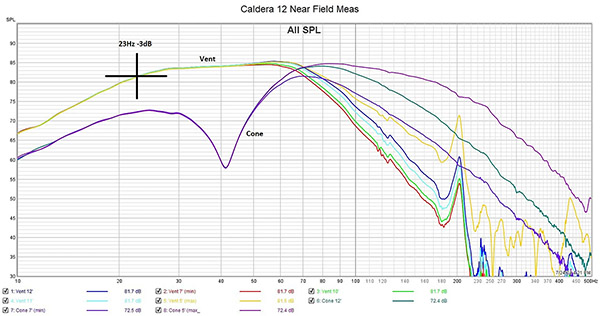
Specs
Scout
● Woofer: 5.25" treated paper cone
● Tweeter: 1" silk dome
● Alignment: Bass reflex, rear port
● Frequency Response: 60Hz (-6dB)
● Impedance: 8 ohms
● Efficiency: 84.5dB
● Power Handling: 50 watts
● Dimensions: 11.75" × 6.75" × 9.5" (HWD)
● Weight: 12 lb
● Finish: Rosewood veneer
● Price: $299/pair
Caldera 12
● Driver: 12-inch high-excursion woofer
● Alignment: Bass reflex, rear slot port
● Amplifier Power: 500 watts RMS (Class D)
● Frequency Response: 23Hz (-3dB)
● Inputs: line level, XLR
● Dimensions: 20" × 20" × 20" (HWD)
● Weight: 44 lb
● Finish: Rosewood veneer with black edgework
● Price: $399/each ($718/pair)


